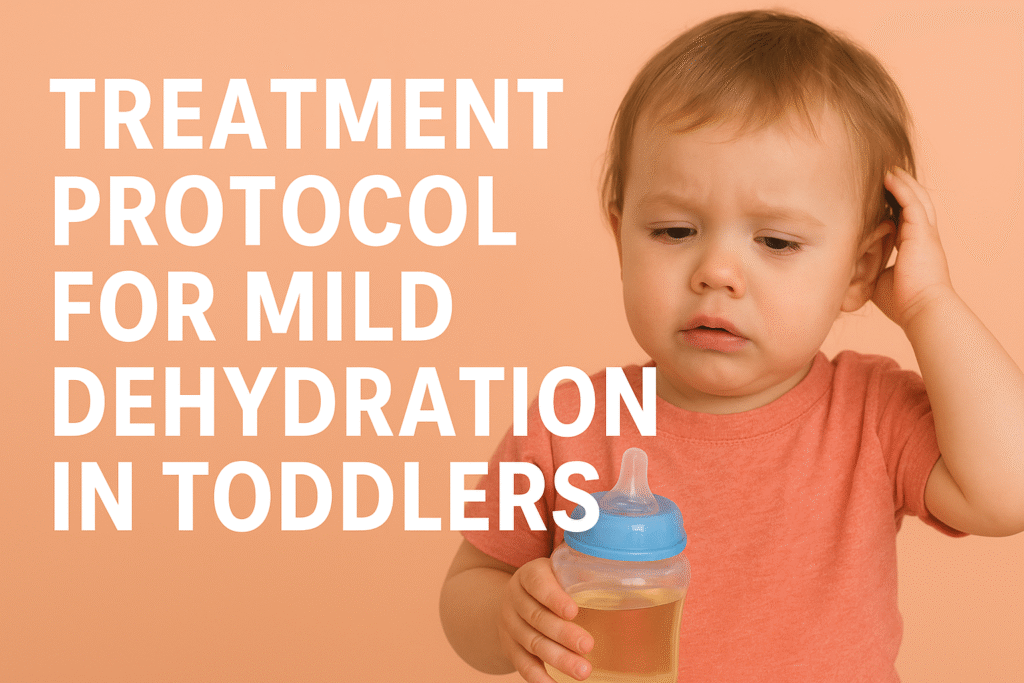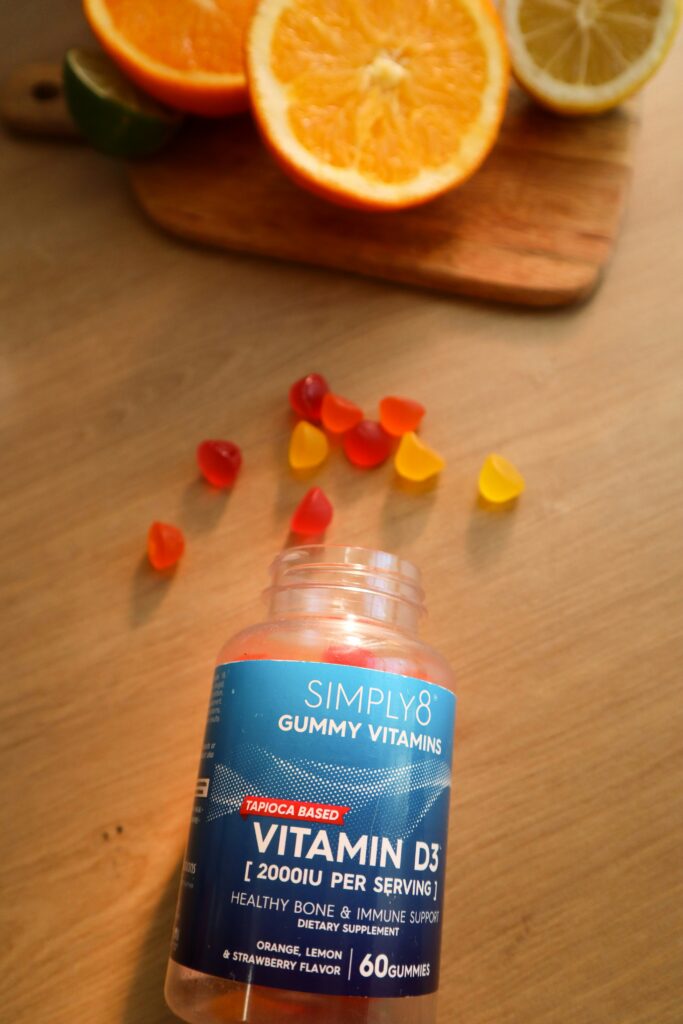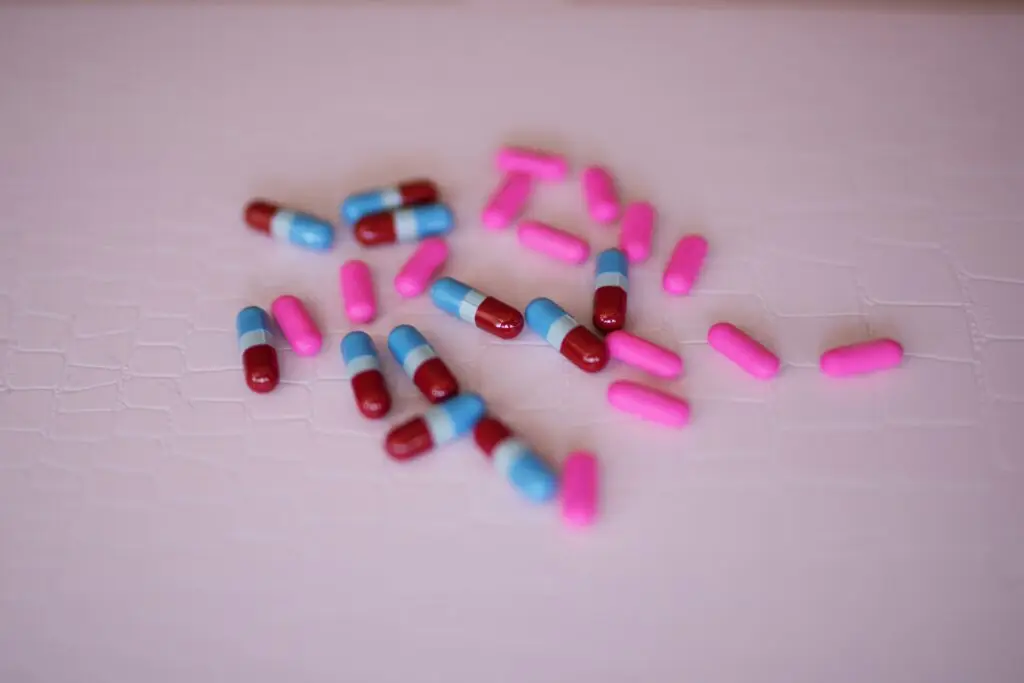
⚠️ Affiliate Disclaimer: This post may contain affiliate links, which means I may earn a small commission — at no extra cost to you — if you make a purchase through one of these links. I only recommend products or services I genuinely trust and believe can provide value. Thank you for supporting My Medical Muse!
Treatment for Mild Dehydration in Toddlers
Treatment protocol for mild dehydration in toddlers
If you’re a parent, you already know how quickly toddlers can go from running around happily to looking tired and unwell. One common but often underestimated reason for this sudden change is mild dehydration.
Dehydration simply means your child doesn’t have enough fluid in their body to keep things running smoothly, and in toddlers, this can happen surprisingly fast. Why? Because their little bodies are made up of a higher percentage of water compared to adults, and their metabolisms work at full speed. Add to that the fact that toddlers can’t always say, “I’m thirsty”, and you’ve got a recipe for rapid fluid loss.
Some situations make dehydration even more likely:
- Illness: A stomach bug with vomiting or diarrhea can drain fluids quickly.
- Fever: Even a mild fever speeds up fluid loss through sweating and faster breathing.
- Hot weather: Outdoor play under the sun can cause toddlers to sweat more than we realize.
- Low fluid intake: Sometimes they’re just too distracted playing to drink enough.
Here’s the important thing, mild dehydration is not usually dangerous on its own, and in most cases, you can manage it effectively at home, if you catch it early. The danger comes when it’s missed or ignored, because it can quickly progress to moderate or severe dehydration, which is a medical emergency that requires urgent hospital care.
The good news? With the right knowledge, you can spot the signs early and take steps to rehydrate your toddler safely.
In this guide, we’ll cover:
- How to recognize the early warning signs (even the subtle ones most parents miss)
- Step-by-step home treatment using the safest, most effective methods
- When to call the doctor immediately
- Easy, practical prevention tips to keep dehydration from happening in the first place
We’ll be following the gold-standard advice from trusted medical organizations like the World Health Organization (WHO), the American Academy of Pediatrics (AAP), and the Centers for Disease Control and Prevention (CDC), so you can feel confident that the steps you’re taking are evidence-based and safe for your child.
By the end, you’ll have a clear, parent-friendly action plan that you can follow anytime your toddler shows early signs of dehydration, helping you stay calm, take quick action, and protect your little one’s health.
Why Toddlers Are at Higher Risk
You might wonder why toddlers can get dehydrated more quickly than older kids or adults. Here’s why:
- Smaller fluid reserves: A toddler’s body contains more water relative to their size, but they don’t have big “storage tanks” like adults do. If they lose fluid, even a small amount, it makes a bigger impact.
- Faster turnover: Toddlers breathe faster, have quicker heart rates, and burn energy more rapidly. This means they use up fluids at a faster pace, even when they’re just playing or napping.
- Dependent on caregivers: A toddler can’t always say, “I’m thirsty,” and sometimes they don’t even recognize thirst until it’s more serious. They rely on you to notice the signs and offer fluids regularly.
- More vulnerable to illness: Fevers, diarrhea, and vomiting are frequent visitors in the toddler years. Each of these conditions can strip the body of water and electrolytes quickly.
Common Causes of Mild Dehydration in Toddlers
Understanding what typically causes fluid loss can help you take quick preventive action. Here are the most common culprits:
1. Viral Gastroenteritis (“Stomach Flu”)
This is the number one cause of dehydration in toddlers worldwide. A stomach bug often comes with vomiting and diarrhea, which drain fluids and electrolytes rapidly. Even if it lasts only a day, the fluid loss can be significant especially if your toddler isn’t drinking enough in between episodes.
Parent tip: Start offering oral rehydration solution (ORS) at the very first sign of vomiting or loose stool, rather than waiting.
2. Fever
When your toddler has a fever, their body temperature rises, and they lose more fluids through sweating. Breathing tends to become faster, which also increases water loss through the lungs. Even without vomiting or diarrhea, a high fever alone can cause mild dehydration if fluids aren’t replaced.
3. Hot Weather or Overexertion
Toddlers don’t regulate their body temperature as efficiently as older children or adults. When they play outside in the sun, especially in warm or humid conditions, they may sweat more than you realize and they often get too distracted to stop and drink.
Parent tip: Offer small sips of water every 15-20 minutes during active outdoor play in warm weather.
4. Poor Fluid Intake
Sometimes the problem isn’t losing fluids, it’s simply not getting enough in. This can happen if your toddler is:
- Distracted by toys or activities
- Going through a picky eating phase
- Unwell and refusing food or drinks
- Transitioning from breast/bottle to cup and not yet drinking enough
Even a day or two of reduced drinking can cause mild dehydration.
5. Common Colds and Respiratory Infections
While colds may seem mild, they often lead to faster breathing, nasal congestion, and reduced appetite, all of which can mean less fluid intake and more fluid loss. Plus, if your toddler has a runny nose, they’re losing extra water content through mucus production.
Recognizing Mild Dehydration in Toddlers
Spotting dehydration early can make all the difference in preventing a trip to the hospital. The challenge is that toddlers may not be able to tell you exactly how they’re feeling, so you’ll need to rely on physical signs and subtle changes in behavior. Here’s what to look for:
- Dry or sticky mouth:
Check your child’s tongue and lips. If they look dry, cracked, or sticky, it’s a red flag that fluid levels are low. - Reduced urine output:
- For diapered toddlers: Fewer wet diapers than usual (less than 4 in 24 hours).
- For potty-trained toddlers: Fewer trips to the toilet or noticeably smaller amounts of urine.
- Darker yellow urine:
Pale yellow is normal. Darker, more concentrated urine is a sign your toddler’s body is conserving water. - Mild irritability or fussiness:
Dehydrated children may become cranky or unusually difficult to comfort. This isn’t “just a mood”, it can be their body’s way of signaling discomfort. - Thirst and eagerness to drink:
While thirst is an obvious sign, remember that by the time a toddler says they’re thirsty, they may already be mildly dehydrated. - Slightly sunken eyes:
Look for a subtle shadowing or hollow appearance around the eyes. - Warm skin with less elasticity
Gently pinch the skin on the back of their hand. In a well-hydrated child, it should snap back quickly. If it takes longer than a second or two, they may be low on fluids. - Fewer tears when crying
A toddler who’s crying hard but producing very few or no tears likely needs fluid replacement.
Important: If your toddler develops extreme sleepiness (lethargy), a rapid heartbeat, very sunken eyes, cold hands or feet, or is unable to drink, it may no longer be mild dehydration seek urgent medical care.
Also Read: Everything You Need To Know About Dehydration
Step-by-Step Home Treatment Protocol
When you notice mild dehydration, acting quickly but calmly is the key.
1. Goal of Treatment
The aim is simple: replace the lost fluids and electrolytes gradually without overwhelming the stomach, which can trigger more vomiting.
2. Oral Rehydration Therapy (ORT): The Gold Standard
Oral Rehydration Therapy is the safest, most effective way to treat mild dehydration in toddlers. It replaces both water and electrolytes in the right proportions, something plain water alone can’t do.
What You’ll Need:
- Commercial Oral Rehydration Solution (ORS) such as Pedialyte®, Hydralyte®, or WHO-ORS packets mixed with clean water.
- A small cup, spoon, or bottle: whichever your child accepts most easily.
Dosage Guidelines for Mild Dehydration
The World Health Organization (WHO) and the American Academy of Pediatrics (AAP) recommend giving 10–20 mL of ORS per kilogram of body weight over the first hour.
| Weight | Volume in First Hour | How to Give |
| 10 kg ( 22 lbs) | 100-200 mL | Small sips every 5 minutes |
| 12 kg ( 26 lbs) | 120-240 mL | Offer every 5–10 minutes |
| 15 kg ( 33 lbs) | 150-300 mL | Spoonfuls if nauseous |
Practical Tips:
- If your toddler is vomiting, offer just 5 mL (1 teaspoon) every 1–2 minutes. Once they keep this down for 15-20 minutes, you can slowly increase the amount.
- Room-temperature ORS is often easier on the stomach than very cold drinks.
- Avoid forcing large amounts at once, this can trigger vomiting.
If ORS is not immediately available
While ORS is ideal, you can temporarily use:
- Diluted fruit juice (half juice, half water)
- Clear broth
- Water with a small salty snack (like a plain cracker) to help replace sodium
Avoid: Undiluted fruit juice, sodas, energy drinks, or sports drinks, they’re too high in sugar and low in the right electrolyte balance.
Suitable Fluids for Mild Dehydration
When it comes to rehydrating a toddler, the type of fluid matters just as much as the amount. Giving the wrong drink can sometimes make symptoms worse, so it’s important to know the best options and what to avoid.
Best choice, Oral Rehydration Solution (ORS):
- ORS contains the perfect balance of water, salts, and glucose for quick absorption.
- Commercial brands like Pedialyte, Hydralyte, and WHO-approved ORS packets are safe and effective.
- Always mix ORS powder exactly as instructed, using too much or too little water changes the concentration and can make it less effective.
Acceptable alternatives if ORS isn’t immediately available:
- Diluted fruit juice (half juice, half water), provides some natural sugars and potassium without the high sugar load that can worsen diarrhea.
- Clear broth: helps replace sodium, but should be low in fat and not overly salty.
- Plain water with a small salty snack: if nothing else is available, pair water with something like a plain cracker to help replenish sodium.
Drinks to avoid during mild dehydration:
- Undiluted juice: high sugar draws more water into the intestines, which can worsen diarrhea.
- Carbonated soft drinks: gas can cause bloating and discomfort.
- Energy drinks: unsafe for children due to caffeine and high sugar.
- High-sugar sports drinks: not balanced for a toddler’s electrolyte needs and can upset the stomach.
Parent tip: If your toddler refuses ORS, try serving it in a colorful cup or with a straw, sometimes presentation makes all the difference.
3. Continue Feeding
One common mistake parents make is stopping all food during dehydration, but this can actually slow recovery. A toddler’s body needs both fluids and nutrients to regain energy and restore balance.
During mild dehydration, continue feeding by:
- Breastfeeding or formula feeding: Breast milk and formula provide both hydration and essential nutrients.
- Offering small, frequent meals: Gentle foods are best, such as
- Mashed bananas
- Rice or rice porridge
- Applesauce
- Toast or plain crackers
- Including easy-to-digest protein once tolerated, such as scrambled egg or plain yogurt.
Foods to avoid until recovery:
- High-fat foods: fried items or creamy sauces are harder to digest.
- Highly seasoned or spicy foods: can irritate the stomach and intestines.
- Very sugary treats: can cause more water loss in the intestines.
Why continuing to feed matters:
- Prevents low blood sugar
- Maintains strength during recovery
- Helps repair the gut lining after diarrhea or vomiting
If your toddler refuses solid food, don’t panic, the priority is fluid replacement. Keep offering food every couple of hours, but don’t force it.
4. Monitor Recovery
Once you’ve started treatment, it’s essential to track your toddler’s progress. Improvement can be seen fairly quickly if dehydration is mild and treatment is consistent.
Signs of recovery within 4-6 hours include:
- Increased urination: more frequent wet diapers or trips to the potty.
- Brighter mood: more energy, playing or talking more.
- Moist lips and mouth: dryness should noticeably reduce.
- Improved skin elasticity:skin “pinch test” returns to normal.
When to get medical help:
If after 4-6 hours you notice no improvement or symptoms worsen, contact your pediatrician immediately. Seek urgent care if your toddler develops:
- Persistent vomiting (unable to keep fluids down)
- Signs of moderate/severe dehydration (very sleepy, rapid heartbeat, cold extremities)
- Blood in stool or vomit
- High fever that doesn’t respond to treatment
Early action and close monitoring are the best ways to keep mild dehydration from becoming dangerous.
When to Call the Doctor Immediately
Call your pediatrician or go to the ER if:
- Toddler is under 6 months old and showing dehydration signs
- Persistent vomiting prevents fluid intake
- Diarrhea lasting more than 24 hours
- Blood in stool or vomit
- Signs of moderate/severe dehydration (listlessness, rapid pulse, cold extremities, sunken fontanelle in infants)
- Weight loss >5% in a few day
Preventing Dehydration in Toddlers
1. Daily Hydration Needs:
General rule of thumb for healthy toddlers:
About 1-1.3 liters (4 to 5 cups) of fluids per day, from both drinks and high-water foods.
2. Practical Prevention Tips
- Offer water regularly, don’t wait for them to ask.
- Increase fluids during hot weather and illness.
- Keep ORS packets at home for emergencies.
- Use fun cups or straws to encourage drinking.
- Include water-rich foods (watermelon, cucumber, oranges)
Sample Home Rehydration Plan for a 2-Year-Old (12 kg)
Hour 1:
150 mL ORS given as 5-10 mL every 5 minutes.
Hour 2-4:
Continue ORS as tolerated, up to 600-800 mL total over 4 hours.
During Meals:
Soft solids like mashed banana, rice porridge.
Continue breastfeeding/formula.
Ongoing:
Return to normal diet once fully recovered.
Encourage water throughout the day
Myths About Treating Dehydration in Toddlers
- Give plain water only: Not enough, electrolytes are essential.
- Stop feeding during diarrhea: is wrong. Continued feeding helps recovery.
- Sports drinks are fine: No, they’re too high in sugar and low in needed electrolytes.
Conclusion- Acting Early Makes All the Difference
Mild dehydration in toddlers can sneak up quickly, but it’s also one of the easiest health issues to turn around when caught early. The key is knowing what to look for, how to respond, and when to get help.
By keeping an oral rehydration solution in your home, offering fluids regularly (especially during illness or hot weather), and continuing gentle, nutritious feeding, you give your child the best chance to recover quickly and comfortably.
Remember, toddlers rely on us to notice the signs they can’t always express. A few extra sips of the right fluids at the right time can prevent a trip to the hospital and protect your child’s health. Stay observant, stay prepared, and trust your instincts, you know your toddler best and with the right steps, you can keep dehydration from ever becoming more than a mild bump in their day.
👩⚕️ Need Personalized Health Advice?
Get expert guidance tailored to your unique health concerns through MuseCare Consult. Our licensed doctors are here to help you understand your symptoms, medications, and lab results—confidentially and affordably.
👉 Book a MuseCare Consult NowRelated Post You Might Like:
- Dehydration Headache? 10 Proven Ways to Stop It Fast & Stay Pain-Free
- When to Refer Recurring Headaches to a Neurologist: 7 Key Signs You Can’t Ignore
- Recognizing Early Signs of Thyroid Storm in Adults: 7 Critical Warning Clues
- 10 Life-Changing Morning Habits That Naturally Lower Blood Pressure
- Sweet Taste in Mouth: Shocking Signs It’s a Vitamin Deficiency


